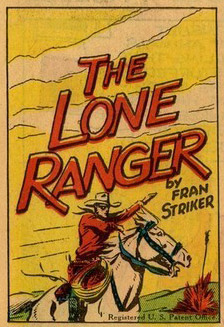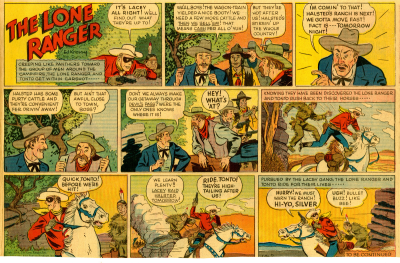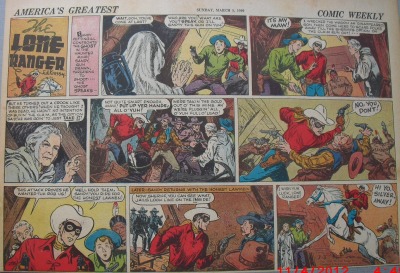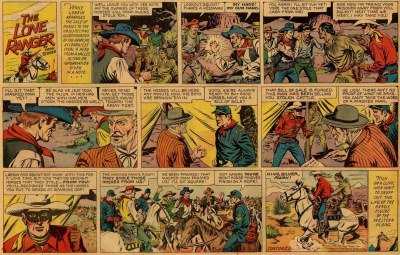Vanaf 1967 verschijnt de Lone Ranger in het Nederlands onder de naam “De gemaskerde ruiter” in de jeugdkrant Heintje, een stripblad van de Albert Hein.




Ik vind de strips getekend door Charles Flanders niet zo bijzonder, daarom nog een paar (mooiere) verhalen van internet geplukt.
In het engels:
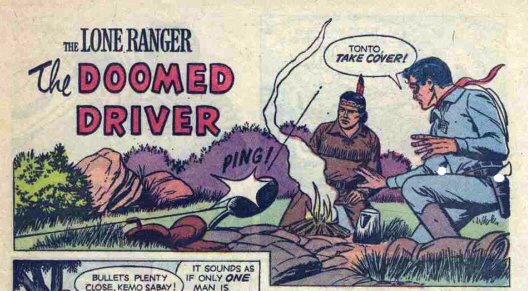
The Lone Ranger and the hooded

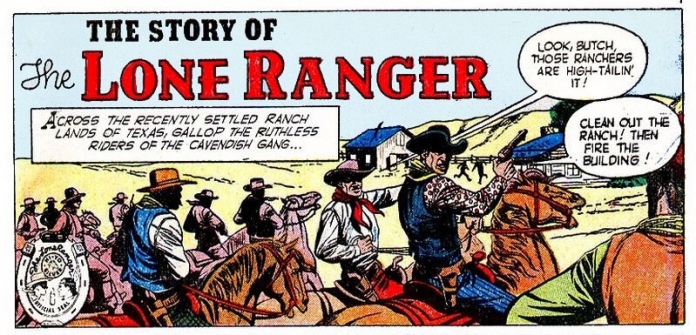
The Lone Ranger he finds Dan Reid
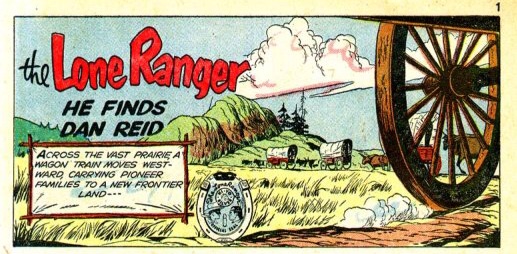
The story of the Lone Ranger (different version)
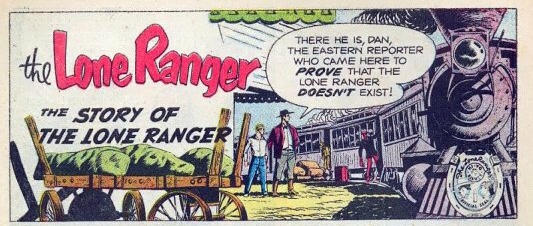
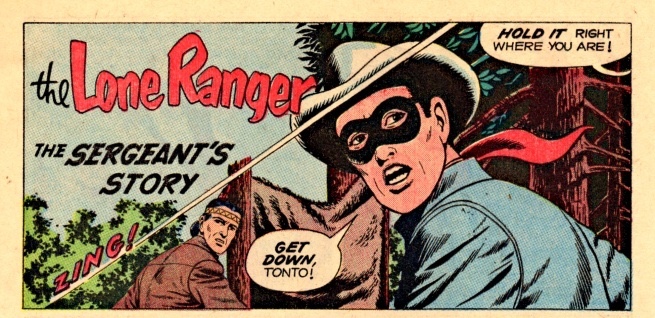
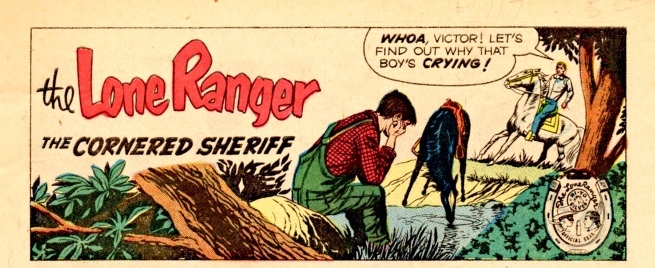
Uit de Wikipedia:
The Lone Ranger is een Amerikaanse westernserie die in 1933 begon als een radio-hoorspel, en daarna van 1949 tot 1957 als televisiereeks te zien was.
|
The Lone Ranger
|
||||
 |
||||
| Genre | Western | |||
| Speelduur | 30 minuten | |||
| Hoofdrollen | Jay Silverheels Clayton Moore John Hart |
|||
| Scenario | Dwight V. Babcock Hal G. Evarts |
|||
| Land van oorsprong | ||||
| Taal | Engels | |||
| Uitzendingen | ||||
| Start | 15 september 1949 | |||
| Einde | 6 juni 1957 | |||
| Afleveringen | 221 (5 seizoenen) | |||
| (en) IMDb-profiel | ||||
|
||||
De hoofdpersoon, The Lone Ranger, is een gemaskerde Texaanse Ranger (een soort politieagent) die op zijn trouwe paard, Silver, het kwaad bestrijdt. Hij wordt daarbovenop ook nog regelmatig bijgestaan door zijn trouwe indiaanse metgezel Tonto. De herkenningsmelodie van The Lone Ranger was Gioacchino Rossini’s “Willem Tell“ ouverture. De kreet, “Hi-ho Silver, away!”, werd een populaire catchphrase.
De avonturen van The Lone Ranger and Tonto verschenen ook als strip onder dezelfde naam, The Lone Ranger, in Amerikaanse dagbladen van 1938 tot 1971, en later opnieuw van 1981 tot 1984. Een Nederlandse overgetekende bewerking werd in de jaren vijftig door ATH (Arnoldus Teeuwen Handelsdrukkerij) uitgebracht onder de naam De Onbekende Stille; in deze reeks verschenen ruim 100 titels.
The lone Ranger verschijnt al vanaf 1933 in de Amerikaanse kranten. Er zijn films van gemaakt en een televisieserie.
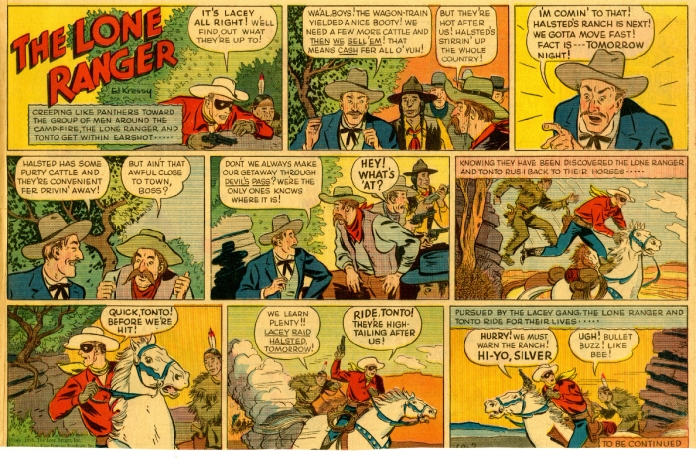
Er zijn verhalen in magazines gepubliceerd met vaak hele mooie covers, maar deze bladen zijn wel op een ander formaat.
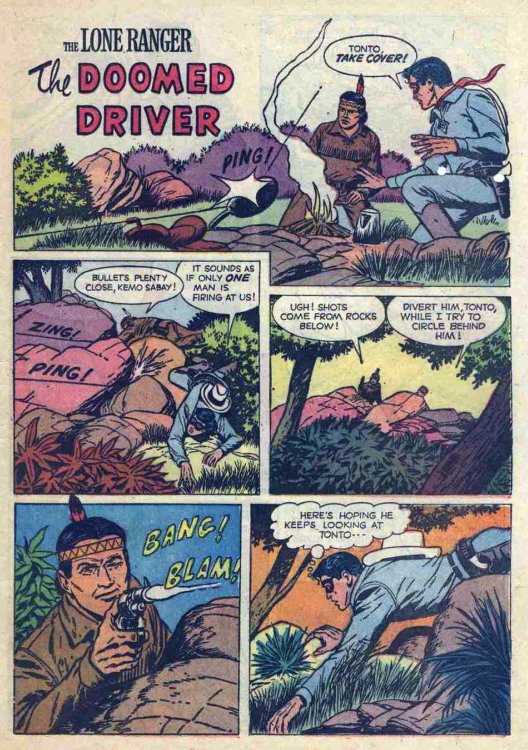
Enkele covers:
Ik heb de verhalen uit de Heintje gescand, ze zijn op het formaat van de sundaypapers, ook heb ik enkele verhalen in het Engels van internet geplukt, een mooie sit daarvoor is:
https://newspapercomicstripsblog.wordpress.com/2016/02/20/lone-ranger/
Vanuit die site kun je ook strips downloaden van Batman, Fantoom, Rip Kirby, Mandrake en nog veel meer Amerikaanse krantenstrips.
meer info, maar dan in het Engels over de comics:
The Lone Ranger is a fictional masked former Texas Ranger who fought outlaws in the American Old West with his Native American friend, Tonto. The character has been called an enduring icon of American culture.[7]
| Lone Ranger | |
|---|---|

Clayton Moore as the Lone Ranger
|
|
| Publication information | |
| First appearance | WXYZ (January 30 or 31, 1933) |
| Created by | Fran Striker[1][2] or George W. Trendle[3][4][5] |
| In-story information | |
| Alter ego | Ranger Reid |
| Team affiliations | Texas Rangers |
| Partnerships | Tonto |
| Abilities | Expert marksman [6] Above-average athlete, horseman, hand-to-hand combatant, and master of disguise |
He first appeared in 1933 in a radio show conceived either by WXYZ (Detroit) radio station owner George W. Trendle,[3][4][5] or by Fran Striker,[8] the show’s writer.[9][10] The radio series proved to be a hit and spawned a series of books (largely written by Striker), an equally popular television show that ran from 1949 to 1957, comic books, and several movies. The title character was played on the radio show by George Seaton, Earle Graser, and Brace Beemer.[8] Clayton Moore portrayed the Lone Ranger on television, although during a contract dispute, Moore was replaced temporarily by John Hart, who wore a different style of mask. On the radio, Tonto was played by, among others, John Todd and Roland Parker; and in the television series, by Jay Silverheels, who was a Mohawk from the Six Nations Indian Reserve in Ontario, Canada.
The Lone Ranger was a TV show that aired for eight seasons, from 1949 to 1957, and starred Clayton Moore as the Lone Ranger and Jay Silverheels as Tonto. Only five of the eight seasons had new episodes. It was the ABC television network’s first big hit of the early 1950s.[20] Moore’s tenure as the Ranger is probably the best-known treatment of the franchise.[34] Moore was replaced in the third season by John Hart,[35][36] but he returned for the final two seasons. The fifth and final season was the only one shot in color. A total of 221 episodes were made.
Hi-Yo Silver!, Kemo sabe, and other cultural tropesEdit
At the beginning of each episode, the magnificent white stallion, Silver, would rear up with the Lone Ranger on his back, then they would dash off, the Ranger encouragingly shouting, “Hi-Yo, Silver!”[37] Tonto could occasionally be heard to urge on his mount by calling out, “Get ‘em up, Scout!” At the end of each episode, mission completed, one of the characters would always ask the sheriff or other authority, “Who was that masked man?” When it was explained, “Oh, he’s the Lone Ranger!”, the Ranger and Tonto would be seen galloping off with the cry, “Hi-Yo, Silver! Away!” catching the attention of one of the townspeople crossing the street.
Tonto usually referred to the Lone Ranger as “Kemo sabe“, described as meaning either “faithful friend,” or “trusty scout”.[12][38] It is more likely the word derives from the Anishnaabe language. Gimoozaabi is said to mean “he looks out in secret.” [39] These catchphrases, the Ranger’s trademark silver bullets, and the theme music from the William Tell Overture have become tropes of popular culture.[citation needed]
Comic strip
King Features Syndicate distributed a newspaper strip of the Lone Ranger from September 1938 to December 1971. Fran Striker himself initially scripted the feature, but time constraints soon required him to quit, replaced by Bob Green, later followed by Paul S. Newman and others.[46] The original artist was Ed Kressy, but he was replaced in 1939 by Charles Flanders who drew the strip until its conclusion.[47]
In 1981, the New York Times Syndicate launched a second Lone Ranger strip, written by Cary Bates with art by Russ Heath.[48] It ran until 1984. In 1993 Pure Imagination Publishing collected two of the storylines and put them in a comic book.
Comic books
In 1948, Western Publishing, with its publishing partner Dell Comics, launched a comic book series which lasted 145 issues. This originally consisted of reprints from the newspaper strips (as had all previous comic book appearances of the character in various titles from David McKay Publicationsand from Dell). However, new stories by writer Paul S. Newman and artist Tom Gill began with issue #38 (August 1951). Some original content was presented as early as #7 (January 1949), but these were non-Lone Ranger fillers. Newman and Gill produced the series until its final issue, #145 (July 1962).[49]
Tonto got his own spin-off title in 1951, which lasted 31 issues. Such was the Ranger’s popularity at the time that even his horse Silver had a comic book, The Lone Ranger’s Famous Horse Hi-Yo Silver, starting in 1952 and running 34 issues; writer Gaylord DuBois wrote and developed Silver as a hero in his own right. In addition, Dell also published three big Lone Ranger annuals, as well as an adaptation of the 1956 theatrical film.
The Dell series came to an end in 1962. Later that same year, Western Publishing ended its publishing partnership with Dell Comics and started up its own comic book imprint, Gold Key Comics. The new imprint launched its own Lone Ranger title in 1964. Initially reprinting material from the Dell run, original content did not begin until issue #22 in 1975, and the magazine itself folded with #28 in 1977.[50] Additionally, Hemmets Journal AB published a three-part Swedish Lone Ranger story the same year.[citation needed]
In 1994, Topps Comics produced a four-issue miniseries, The Lone Ranger and Tonto, written by Joe R. Lansdale and drawn by Timothy Truman.[51] One of the major changes in this series was the characterization of Tonto, who was now shown to be a very witty, outspoken, and sarcastic character, even willing to punch the Lone Ranger during a heated argument, and commenting on his past pop-culture depictions with the words, “Of course, quimo sabe. Maybe when we talk I should use that ‘me Tonto’ stuff, the way they write about me in the dime novels. You’d like that, wouldn’t you?”.[52]
The first issue of a new Lone Ranger series from Dynamite Entertainment by Brett Matthews and Sergio Cariello shipped September 6, 2006. It has started as a six-issue miniseries, but due to its success, it has become an ongoing series by the same team. On September 15, 2006, Dynamite Entertainment announced that The Lone Ranger #1 had sold out of its first printing. A second printing of the first issue was announced; a first for the company.[53] The series has received an Eisner Awards nomination for best new series in 2007. True West magazine awarded the publication the “Best Western Comic Book of the Year” in their 2009 Best of The West Source Book! And in 2010 Dynamite released “The Lone Ranger Avenges the Death of Zorro”.
The second volume of the series by Dynamite came in January 2012. Written by Ande Parks and drawn by Esteve Polls, it ran for a total of 25 numbers, with the last issue being released in June 2014.[54]
Apart from the ongoing series, Dynamite released several miniseries starring the Lone Ranger, such as The Lone Ranger and Tonto (4 issues, written by Brett Matthews; John Abrams with art by Mario Guevara) in 2008; Snake of Iron, a 5-part by Chuck Dixon and Steve Polls published in 2012, and Vindicated, 4 issues by Justin Gray and Rey Villegas in 2014.
In 2016, The Lone Ranger teamed-up with the Green Hornet for a 5-part written by Michael Uslan with art by Giovani Timpano.[55][56]
PRE-WAR LONE RANGER SUNDAYS (1938-39)
From March 12th onwards, the Sundays are credited on the logo to Fran Striker, the original writer of the radio serial and the first three such Sundays do not feature any signature inside the panels either. However, with the official elimination of the Kressy credit, the art has once again changed, for the better. From April 2nd onwards, the signature of the famed Charles Flanders begins to appear inside the panels. Why Flanders did not sign (or, perhaps, wasn’t allowed to sign) the three Sundays before that is unknown to me. Note that even Flanders has kept those pupils visible on the eyes of the Lone Ranger in his early work, as in the below Sunday from April 9th:
The Lone Ranger rides again
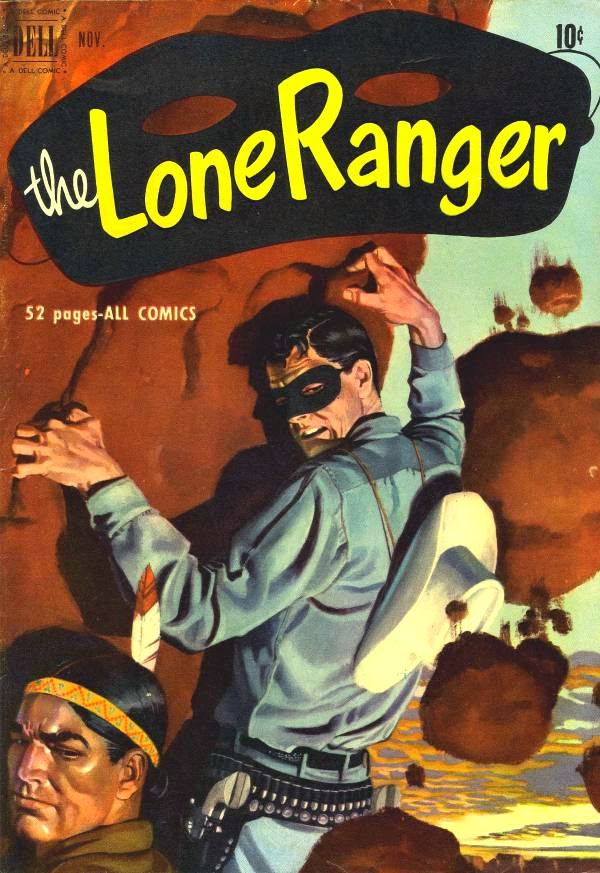
In the heyday of Western comics The Lone Ranger was a popular read from 1948 on, with Western Publishing (a partner of Dell) releasing 145 issues, mostly reworkings of newspaper strip cartoons.
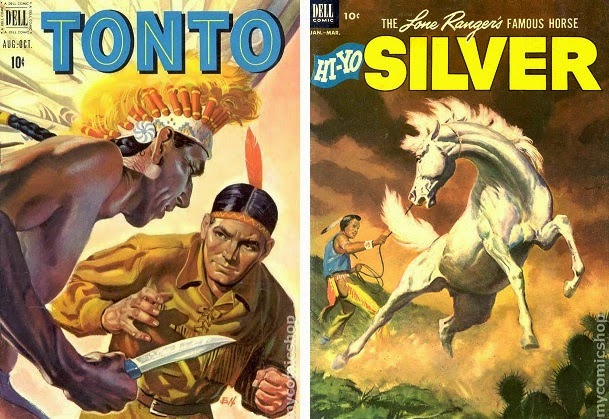
Tonto got his own spin-off title in 1951, which lasted 31 issues, and so popular was the masked rider that even Silver had a comic, The Lone Ranger’s Famous Horse Hi-Yo Silver, starting in 1952 and running 34 issues. Dell also produced Lone Ranger annuals.
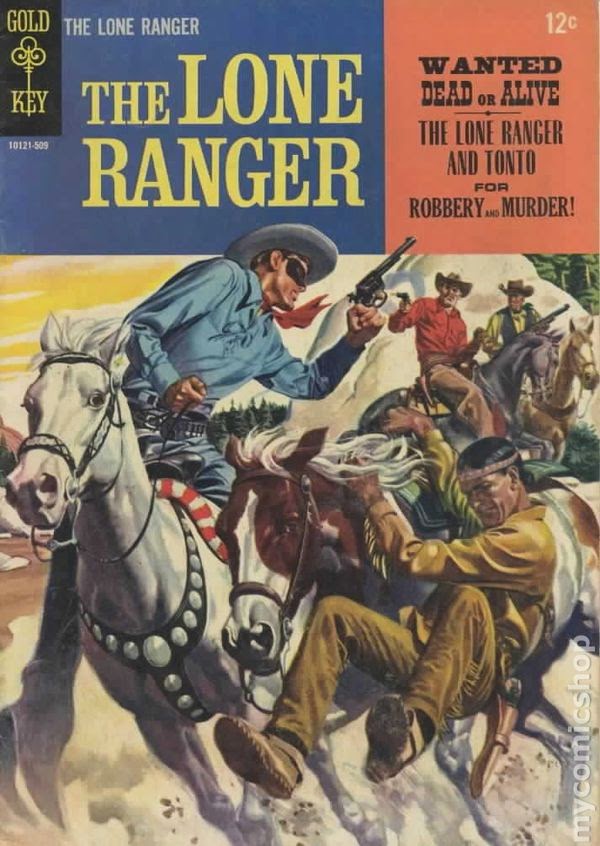
Gold Key Comics launched its own series in 1964 but they were mostly reprints of the Dell efforts; original content did not begin until issue #22 in 1975, and the magazine itself folded with #28 in 1977.
In 1994, Topps Comics produced a four-issue miniseries, The Lone Ranger and Tonto, written by Joe R. Lansdale and drawn by Timothy Truman. In these, Tonto was shown to be an outspoken character, even willing to punch the Lone Ranger during an argument, and commenting on his past pop-culture depictions with the words, “Of course, quimo sabe. Maybe when we talk I should use that ‘me Tonto’ stuff, the way they write about me in the dime novels. You’d like that, wouldn’t you?” Progress, you see.







































